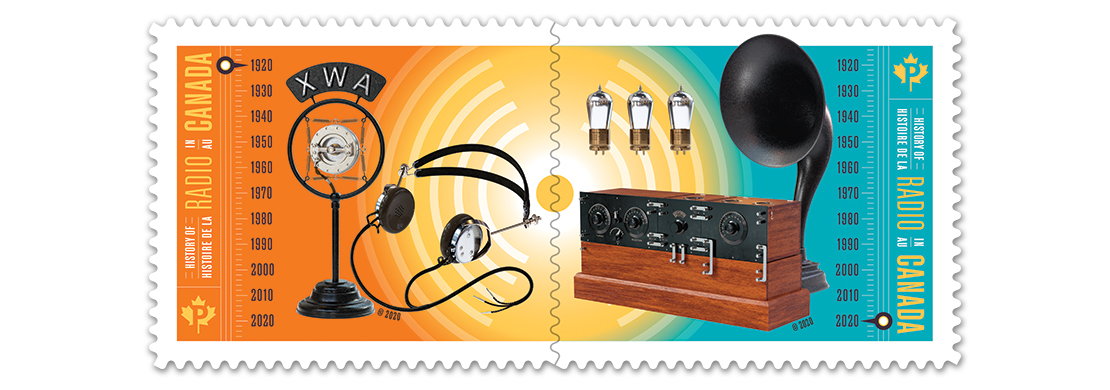On the evening of May 20, 1920, members of the Royal Society of Canada gathered at Ottawa’s Château Laurier to hear a live performance. What was novel, even historic, was that soprano Dorothy Lutton was 200 km away, in Montréal.
Lutton’s performance was broadcast from radio station XWA (Experimental Wireless Apparatus) at the Marconi factory studios in Montréal. It ushered in the radio age in Canada. Within two decades, millions were listening and radio was reshaping this country. Radio has enthralled us, entertained us, and engaged us in ways that no one in that Ottawa ballroom dreamed of a century ago.
On May 20, 2020, Canada Post will issue a set of stamps marking the 100th anniversary of that first scheduled Canadian radio broadcast and celebrating a century of radio in our country.

Station XWA soon changed its call letters to CFCF – for “Canada’s First, Canada’s Finest” – and became a broadcasting powerhouse before leaving the airwaves in 2010. In 1922, CKAC, one of 34 licensed stations in Canada, became the first in North America to offer French-language programming. Radios were still a luxury beyond the reach of many, but more than 300,000 Canadian households eagerly welcomed the new medium into their living rooms in its first decade.
Early adaptors depended on homebuilt systems
Many early consumers of radio built their own relatively primitive receivers, often little more than a wooden box containing a jumble of wires and other hardware, and listened through a head set. The advent of affordable vacuum tubes, which amplified radio signals and converted them to sound, made it possible for people in the same room to listen together.
Canadian consumers began to demand the latest in radio technologies, and the manufacturing and selling of radio became lucrative. Recognizing the potential of the new technology, retailers like the T. Eaton Company created specialized catalogues and cultivated a tech-savvy sales staff.
A century of bringing the world into our homes
Over the past 100 years, Canadians have turned to their radios for entertainment and up-to-date news, and to discuss and debate current events. News from around the world – from the economic despair of the Great Depression to movements on the European battlefront – made their way to listeners in homes and driving their cars. So did important national stories, such as Terry Fox’s Marathon of Hope and Fort McMurray’s devastating fire.
Via radio broadcasts, we have shared our nation’s highs and lows: cheered our new flag, felt the pride of the Vancouver Olympic Games, and mourned the losses of 9/11, SARS and COVID-19. Radio tells us if we’re in danger from extreme weather or natural disasters – and gives us the all clear when it’s safe.
Radio also breathed life into social and cultural trends, making new kinds of music popular, even controversial in its time. It gave audiences to new artists and forged careers. Radio whet our appetite for news, music, entertainment and sports in our homes, helping to create the market for future technologies, including television and the Internet.
That first broadcast from Montréal to Ottawa in 1920 was but a taste of all that radio would bring to Canadians over the next 100 years – and our love of and appreciation for the medium continues today.
Stamps celebrate 100 years of radio in Canada
Available now